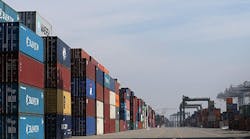As retailers rush to move merchandise from docks to shelves in time to meet the expectations of holiday shoppers, imports continue to remain at near-record levels for the remainder of the year, according to the Global Port Tracker report released by the National Retail Federation and Hackett Associates.
“Dockworkers are unloading ships as fast as they can, but the challenge is to move the containers out of the ports to make room for the next ship,” NRF vice-president for Supply Chain and Customs Policy Jonathan Gold said, in a statement. “We need better empty return procedures and more chassis, truck drivers, rail capacity and warehouse workers to keep the system moving. Retailers have enough inventory on hand to make sure shoppers won’t go home empty-handed this holiday season. But there are still items sitting on the docks or waiting on ships that need to make it to store shelves and online sellers’ warehouses. Retailers want to make sure customers have product choices.”
Last week, in excess of 70 ships were waiting to dock at the Ports of Los Angeles and Long Beach. At Los Angeles, the wait has averaged two weeks over the past month. Due to this situation, some carriers have announced plans to divert to other locations, but congestion is building nationwide.
“The once-vaunted supply chain continues to come under pressure from all sides,” Hackett Associates Founder Ben Hackett said, citing issues ranging from port congestion in the United States to electrical shortages impacting production in China. “It does not look like the congestion will improve any time soon, with most commentators suggesting problems will continue well into 2022 – and that is assuming COVID-19 does not spike again.” Congestion and disruptions that began in 2020 have continued through the current “peak season” for shipping when retailers normally stock up for the holidays, but many retailers anticipated the challenge and began bringing in holiday goods months ahead of schedule to be sure sufficient inventory would be available."
The industry group has previously forecast growth between 8.5% and 10.5% over 2020. U.S. ports covered by Global Port Tracker handled 2.14 million Twenty-Foot Equivalent Units in September, the latest month for which final numbers are available. That was down 5.9% from August but up 1.4% year over year.
Ports have not reported October numbers yet, but Global Port Tracker projected the month at 2.19 million TEU, down 1.2% from October 2020. The year-over-year decline would be the first since July 2020, after which unusually high import volumes began to arrive when stores closed by the pandemic reopened and retailers worked to meet pent-up consumer demand and to stock up for the holidays. Even with the year-over-year decline, October would be among the five busiest months on record since NRF began tracking imports in 2002. Busy cargo is expected to continue through the end of the year, with November forecast at 2.17 million TEU, up 3.3% year-over-year, and December at 2.18 million TEU, up 3.5%.
January 2022 is forecast at 2.21 million TEU, up 7.6% from January 2021; February at 2 million TEU, up 7% year-over-year, and March at 2.17 million, down 4.1%t year-over-year.
The first half of 2021 totaled 12.8 million TEU, up 35.6% from the same period last year.
For the full year, 2021 is on track to total 26 million TEU, up 17.9% over 2020 and a new annual record topping last year’s 22 million TEU.
Cargo imports during 2020 were up 1.9% over 2019 despite the pandemic.



